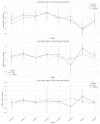Asymmetric Spread Analysis of Heart Rate Variability in XC Mountain Biking During a 20-Minute Autonomic Profile Test
- PMID: 40807842
- PMCID: PMC12349292
- DOI: 10.3390/s25154677
Asymmetric Spread Analysis of Heart Rate Variability in XC Mountain Biking During a 20-Minute Autonomic Profile Test
Abstract
The heart is innervated by the autonomic nervous system (ANS), which plays a role in regulating the heart rate. Cross-country mountain biking (MTBXC) is a sport with high physiological demands, where the autonomic nervous system plays a significant role. The main objective of this study was to analyze the asymmetry of heart rate in Colombian National Team mountain bikers, sub-23 category, during a 20 min cardiovascular autonomic profile test.
Method: The cardiovascular autonomic profile was measured through heart rate variability during a 20 min test, divided into eight phases (supine, controlled ventilation at 10 cycles/min, controlled ventilation at 12 cycles/min, postural change, orthostasis, Ruffier test, 1 min recovery, and final recovery) in a group of n = 10 MTB cyclists from the National Sub-23 Team, including 5 males and 5 females.
Results: The results for the male athletes were as follows: age: 19 ± 1 years; VO2max: 67.5 mL/kg/min; max power: 355 W; HRmax: 204 bpm. The results for the female athletes were as follows: age: 19 ± 1 years; VOmax: 58.5 mL/kg/min; max power: 265 W; HRmax: 194 bpm. Both genders showed the expected autonomic behavior in each phase. Asymmetrical propagation of heart rate was observed, with a greater deceleration pattern after postural changes and effort and a symmetrical acceleration pattern in these two phases.
Discussion: Athletes exhibit increased vagal response compared to non-athletes. Mountain bikers show rapid heart rate reduction after exertion.
Conclusion: This study demonstrates how mountain bikers exhibit increased heart rate deceleration following sympathetic stimuli.
Keywords: asymmetry; autonomic nervous system; heart rate variability; mountain biking.
Conflict of interest statement
The authors have no conflicts of interest.
Figures




References
-
- Woerner S. Autonomic Function in Indoor Versus Mountain Bike Riding. [(accessed on 1 June 2025)]. Available online: https://libres.uncg.edu/ir/asu/f/Woerner,%20Shaun%20Thesis.XX.pdf.
-
- Swart A., Constantinou D. The effects of a 3-day mountain bike cycling race on the autonomic nervous system (ANS) and heart rate variability in amateur cyclists: A prospective quantitative research design. BMC Sports Sci. Med. Rehabil. 2023;15:2. doi: 10.1186/s13102-022-00614-y. - DOI - PMC - PubMed
MeSH terms
LinkOut - more resources
Full Text Sources

